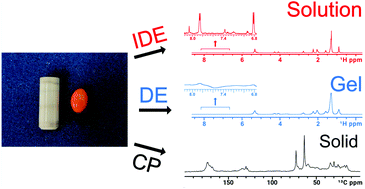Expanding current applications and permitting the analysis of larger intact samples by means of a 7 mm CMP–NMR probe†
Abstract
Comprehensive multiphase NMR combines the ability to study and differentiate all phases (solids, gels, and liquids) using a single NMR probe. The general goal of CMP–NMR is to study intact environmental and biological samples to better understand conformation, organization, association, and transfer between and across phases/interfaces that may be lost with conventional sample preparation such as drying or solubilization. To date, all CMP–NMR studies have used 4 mm probes and rotors. Here, a larger 7 mm probehead is introduced which provides ∼3 times the volume and ∼2.4 times the signal over a 4 mm version. This offers two main advantages: (1) the additional biomass reduces experiment time, making 13C detection at natural abundance more feasible; (2) it allows the analysis of larger samples that cannot fit within a 4 mm rotor. Chicken heart tissue and Hyalella azteca (freshwater shrimp) are used to demonstrate that phase-based spectral editing works with 7 mm rotors and that the additional biomass from the larger volumes allows detection with 13C at natural abundance. Additionally, a whole pomegranate seed berry (aril) and an intact softgel capsule of hydroxyzine hydrochloride are used to demonstrate the analysis of samples too large to fit inside a conventional 4 mm CMP probe. The 7 mm version introduced here extends the range of applications and sample types that can be studied and is recommended when 4 mm CMP probes cannot provide adequate signal-to-noise (S/N), or intact samples are simply too big for 4 mm rotors.

- This article is part of the themed collection: Analyst HOT Articles 2021


 Please wait while we load your content...
Please wait while we load your content...